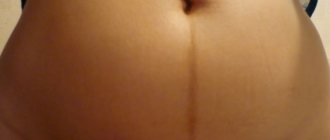A caesarean section is an incision into the uterus to remove a baby, often performed in emergency situations to save a life. But often surgical intervention is planned, due to certain factors and the course of pregnancy. Question, How long does the uterus contract after a caesarean section?, occurs primarily in young mothers, since it is generally accepted that natural childbirth contributes to a faster recovery. However, this statement is inaccurate and lacks validity.
Uterine contraction is one of the main indicators when a woman in labor is discharged from the hospital. The parameter signals recovery, as well as the condition of the uterus - the presence of blood clots and fetal membranes in it. A woman’s uterine deposits come out within almost two months, but they don’t stay in the maternity hospital for that long. In the first days after birth, doctors at a medical institution only monitor the rate of contraction, which determines the state of the body and its readiness for independent recovery. If the uterus contracts slowly, the woman may be prescribed additional medications to promote faster recovery. In particularly difficult cases, the woman in labor is subjected to medical intervention - specialists begin to “clean” the reproductive organ using instruments. To avoid such problems, you should use the recommendations of specialists and effective methods for restoring the uterus after the birth of the baby.
Condition of the uterus after caesarean section
The female uterus is a unique organ. During pregnancy, its size and weight increase several times, the placenta forms in the cavity, and after childbirth, the condition and structure gradually return to prenatal. Physiological childbirth, with the exception of difficult cases, does not lead to disruption of the integrity of the muscular layer of the walls, so the uterus contracts unhindered. On average, this process takes about 6 weeks. In the first 14 days, involution occurs most intensively.
A caesarean section is a serious physical injury that can affect and complicate the natural process. A 12–15 cm long incision in the area of the anterior uterine wall is sutured with a special ligature, which does not require removal and resolves on its own after a few weeks. A transverse suture running along the muscle fibers is relatively safe. Its presence rarely leads to disruption of involution, provided the outcome of the operation is favorable. Vertical dissection of the wall is more traumatic: a larger number of blood vessels and nerve endings are cut, muscle healing takes longer, and because of this there is a high risk of infection. The massive blood loss that accompanies the intervention also slows down subsequent recovery.
How many months have passed since the CS?
1 monthfrom 2 months
After all the manipulations performed during the operation, the uterine cavity is a continuous wound filled with bloody exudate and mucous debris. The swollen organ weighs about 900–1000 years. Its bottom can be clearly felt through the abdominal wall at the level of the navel or below. An ice pack is placed on the abdomen to prevent bleeding. Periodically, the obstetrician massages the organ, encouraging it to begin contracting.
The presence of a seam does not add pleasant sensations to the mother in labor. In the first few days, taking analgesic drugs is indicated. To maintain muscles and reduce pain after getting out of bed, it is recommended to wear thick underwear or a special bandage.
Everything that happens to the uterus after natural childbirth is also characteristic of the operated organ. Closing the walls helps to compress the blood vessels and prevents the development of massive bleeding. At the same time, muscle contraction begins.
List of folk remedies
How long after a cesarean section does the uterus contract, and how to speed up this process using folk methods? Before using any folk remedy, you should consult a doctor, since treatment at home can be very harmful and cause serious complications. You should know that the uterus contracts within two months, but this is an approximate period. Using nettle, you can improve the general condition of a woman after childbirth. To prepare a healing remedy, you need to pour boiling water over the plant and leave to infuse for an hour. Drink 90 ml throughout the day. Leaves of white damselfly must be filled with warm water in a proportion of 3 tbsp. spoons per 600 ml of water. The product should be infused for one day. Before use, strain and take several times a day.
How the uterus contracts after cesarean section
Within 24 hours after the baby and placenta are removed, the walls of the organ decrease by approximately 2–3 cm. After 2 days, you can feel its edge 3–4 cm below the navel. Every day, the bottom drops towards the womb, and the weight of the organ decreases - the tissues get rid of excess fluid and blood clots. Every week the organ decreases by almost 2 times. Normally, 9–12 days after surgery, palpating it through the abdominal wall becomes impossible - it returns to its previous “rightful” place. In this case, the recovery continues until the damaged tissues heal and a full-fledged dense scar is formed at the site of the suture.
A woman can clearly feel how the uterus contracts after a caesarean section through convulsive spasms inside the abdominal cavity. The process is especially intense when oxytocin, the hormone responsible for the secretion of breast milk, is released into the blood. It also stimulates an increase in the tone of muscle fibers.
The involution process can also be monitored by the intensity of postpartum discharge. Caesarean section normally does not affect their character. In the first week, lochia is abundant, bright red in color with brown clots of caked blood, and requires changing several thick pads per day. As the walls of the uterus contract, the fluid brightens, becoming scanty, light pink, then yellowish-whitish. The discharge ends after 6–7 weeks.
How long does the uterus contract after cesarean section?
The period during which the operated uterus returns to its previous size varies from 45 to 70 days. Scar formation takes from 10 months to 2 years.
It should be noted that the speed of recovery is influenced by factors such as:
- the age and physical condition of the woman;
- the presence of systemic disorders in the body;
- seam location;
- what kind of caesarean section it was.
After the first planned operation, performed without complications, the time of uterine contraction does not exceed 50 days. With each new intervention, the muscle walls become thinner, and the presence of scars reduces their elasticity - recovery occurs more slowly.
How many days the uterus contracts after a cesarean section also depends on the formation of lactation. Breastfeeding naturally promotes increased tone - every time a baby is applied to the breast, it causes an oxytocin surge, to which the muscle fibers immediately respond. Lack of milk for any reason, forced or voluntary refusal of the mother to breastfeed provokes a delay in involution.
The uterus is completely restored 1–1.5 years after surgery. Its weight and size remain 1.5 times greater than before the operation. Due to the presence of a scar, the shape may change slightly. Despite the virtual absence of any physical limitations after the rehabilitation period, re-pregnancy before 2 years after surgery should be excluded. The connective tissue in the area of the formed scar acquires the necessary density and resistance to stretching only by this time.
Possible complications
Violations of the contractile functions of the main female reproductive organ after surgery can be of two types - hypotension or atony. In the first case, the uterus contracts too slowly, the rate of its involution lags behind the norms accepted in obstetrics. In the second case, no contractions occur at all.
Hypotension often develops in women who have given birth to their first child. At risk are very young mothers (who are under 19 years old) and older mothers (if the mother in labor was already 36 years old at the time of the operation). Previously performed abortions and diagnostic curettages increase the likelihood of uterine contractions increasing over time and weakening their intensity.
The presence of a scar in itself is a risk of hypotension, which is why reducing drugs are indicated.
But sometimes oxytocin, which is administered to a woman according to a certain scheme, does not have the desired effect. The reason may lie in endocrine diseases of the new mother, as well as in the low position of the fetus during pregnancy, in which the uterine tone was initially uneven (one part of the muscle walls experienced greater tension than others).
If the reduction is delayed
Situations in which the uterus contracts poorly are possible for several reasons.
The most common:
- development of hypoxia: muscles, due to lack of oxygen, receive insufficient nutrition and are unable to quickly regain their tone;
- lack of physical activity: moderate exercise helps restore the body; if a woman spends a lot of time in bed, uterine contractions slow down;
- severe tissue damage: in the presence of a vertical suture, the regeneration of fibers and blood vessels takes up a lot of resources, involution is especially painful;
- intestinal atony: if the contents of the digestive tract move and are excreted with difficulty, the blood circulation of the pelvic organs is disrupted, and the tone of the walls of the reproductive organ decreases;
- uterine inclination: this condition is often accompanied by a sudden cessation of lochia in the early postpartum period, in which case a significant amount of blood and placenta remains accumulate inside the cavity.
Against the background of normal menstruation
Hematometra can occur in seemingly healthy women. The accumulation of blood clots occurs during menstruation when there is an obstruction to the outflow of the contents of the uterine cavity. This can be caused by:
- rigidity of the tissues of the cervical canal - after numerous curettages, including abortions;
- adhesions and adhesions - in the area of the internal os of the cervix;
- polyp - cervical canal;
- submucous fibroids - located near the cervix;
- intrauterine device - and its displacement;
- swelling of the tissues of the cervical canal - due to inflammation, allergies to drugs, contraceptives.
Symptoms of formed hematomas against the background of menstruation force a woman to seek medical help due to intense pain. They can be cutting, pulling, or cramping in nature. Pain occurs due to increased pressure inside the uterine cavity and impact on the internal os. Additionally, urination may become more frequent due to the effect on the bladder. Or the urge to defecate appears when the uterus is retroflexed (positioned backwards).
An important diagnostic criterion for confirming hematometra in this case is the sudden cessation of menstrual flow. After a few hours, the woman notices the appearance of pain.
How to speed up the process
In order for the uterus to shrink faster after a cesarean section to its previous size, the basic principles of recovery should not be neglected.
- After the anesthesia wears off, you need to start moving: get up in bed, raise your arms, bend your knees. You shouldn't lie down all the time. From the second day it is necessary to gradually increase physical activity. How quickly the body recovers directly depends on how much time the patient spends in motion.
- If there are no contraindications, it is recommended to perform Kegel exercises daily: forcefully squeeze and relax the vaginal and gluteal muscles.
- It is advisable to feed a newborn every 3 hours. With each application, a new portion of oxytocin is released into the blood, and the tone of the uterus increases.
- It is important to monitor your digestion. Emptying the intestines is required daily, and the process itself should not cause difficulties. If necessary, it is recommended to take mild laxatives.
The nature and amount of discharge also needs to be monitored, especially if a woman is worried about how to speed up uterine contractions. A feeling of heaviness, swelling and increased pain in the abdominal cavity simultaneously with the cessation of lochia is a sign of a developing pathology. Blood clots blocking the cervical canal can cause further suppuration. In this case, you must seek help immediately.
What do doctors think?
Medical statistics do not record a large number of cases of violation of the timing of uterine involution after cesarean section. The presence of a seam on the front wall often causes the development of infectious processes. However, it is necessary to carefully monitor the reduction in organ volume in the first weeks.
If the uterus does not contract sufficiently in the first weeks, it is advisable to perform an ultrasound, making sure that there are no hematomas, bends, or other possible complications and consequences of the operation that impede involution. In severe cases, the woman is given doses of oxytocin intravenously.
The following help to stimulate an increase in tone: a measured lifestyle, regular breastfeeding or pumping milk, light massage of the abdominal wall. The support bandage should be worn for at least three hours a day in the first weeks.
Each case of recovery after surgical delivery is individual. Usually, by the end of the second month from the day of surgery, the volume of the uterus is reduced to its previous size. The reasons for the slow recovery are: multiple pregnancies, thinning of the walls after several cesarean sections.









